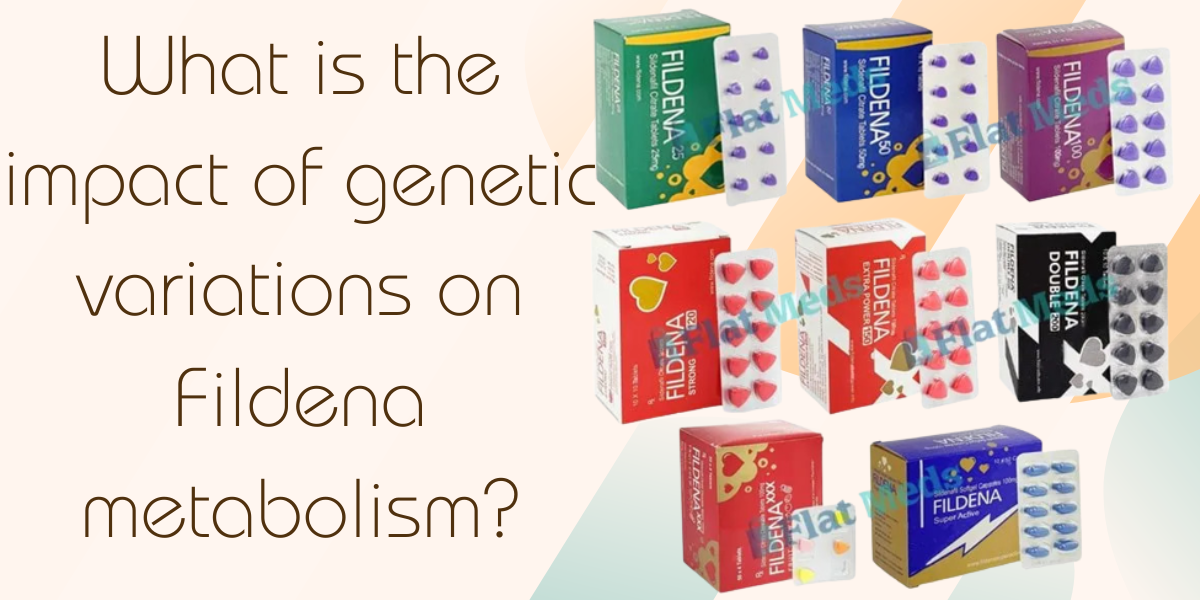Fildena, a widely used medication containing sildenafil citrate, has become a popular choice for treating Erectile disorder. Like many drugs, its effectiveness and safety depend not only on the prescribed dose but also on how an individual's body processes the medication. This processing, or metabolism, can vary significantly from person to person due to genetic differences. In this article, we’ll explore how genetic variations impact the metabolism of Fildena and why understanding these differences is key to personalized and effective treatment.
Understanding Fildena and Its Metabolism
Fildena works by inhibiting an enzyme called phosphodiesterase type 5 (PDE5), which results in the relaxation of blood vessels and improved blood flow to the penis, enabling an erection when sexually stimulated. However, before it can exert its effects, sildenafil must be metabolized primarily in the liver.
The metabolism of Fildena mainly involves enzymes from the cytochrome P450 family, specifically CYP3A4 and to a lesser extent CYP2C9. These enzymes chemically modify sildenafil to prepare it for elimination from the body. The rate and efficiency at which this metabolism occurs determine how much active drug circulates in the bloodstream, affecting both the drug’s efficacy and risk of side effects.
Genetic Variations and Drug Metabolism
Each person’s genetic makeup can influence the structure and function of these metabolic enzymes. Genetic polymorphisms—variations in DNA sequence among individuals—can result in enzymes that are more active, less active, or completely inactive. This concept is the foundation of pharmacogenomics, the study of how genes affect a person’s response to drugs.
Variants in the genes encoding CYP3A4 and CYP2C9 have been identified that change how effectively these enzymes metabolize medications like sildenafil. For example, some individuals may carry gene variants that make these enzymes less efficient, classifying them as “poor metabolizers,” while others may have highly efficient enzyme variants, making them “ultra-rapid metabolizers.”
Impact of Genetic Variations on Fildena Metabolism
Reduced Metabolism: The Slow Metabolizers
Individuals with genetic variants that reduce CYP3A4 or CYP2C9 activity metabolize Fildena more slowly. This slower breakdown means higher concentrations of sildenafil remain in the bloodstream for longer periods. While this might sound beneficial, it can actually increase the risk of adverse effects such as headaches, flushing, dizziness, and low blood pressure.
For instance, the CYP3A4*22 variant is known to decrease enzyme activity, resulting in slower metabolism of many drugs, including sildenafil. Similarly, the CYP2C9*2 and CYP2C9*3 alleles are associated with reduced enzyme function, potentially increasing drug exposure.
Enhanced Metabolism: The Fast Metabolizers
On the other end of the spectrum, some people carry genetic variations that boost the activity of these enzymes, leading to rapid metabolism of sildenafil. For these “fast metabolizers,” the drug is broken down so quickly that effective drug levels may never be reached, reducing the therapeutic effect.
Such individuals might find Sildenafil less effective at standard doses and may require higher doses or alternative treatments to achieve the desired outcome.
Other Genetic Factors
Beyond CYP enzymes, other genes can indirectly affect sildenafil metabolism. For example, the SLCO1B1 gene codes for a protein responsible for transporting drugs into liver cells, which can influence how much sildenafil is available for metabolism.
Clinical Implications
The variability in how Fildena is metabolized due to genetics highlights the importance of personalized medicine in treating Sexual impotence. Understanding a patient’s metabolic profile through genetic testing can help doctors tailor the dosage of Fildena to maximize efficacy while minimizing side effects.
Currently, genetic testing is not routine before prescribing Fildena, but as pharmacogenomic technologies become more affordable and accessible, this could change. Personalized dosing could significantly improve treatment outcomes and patient satisfaction.
Drug Interactions and Compounded Genetic Risk
The picture becomes even more complex when other medications are introduced. Many common drugs—such as ketoconazole, erythromycin, or certain HIV protease inhibitors—are known to inhibit CYP3A4. For someone who is genetically a slow metabolizer, taking such medications concurrently can dangerously increase sildenafil levels, raising the likelihood of severe side effects.
Conversely, drugs that induce CYP enzymes can lower sildenafil plasma concentrations, reducing effectiveness, especially in genetically fast metabolizers. This interplay between genetics and drug interactions emphasizes the need for careful medical supervision.
The Future of Pharmacogenomics in ED Treatments
The future of ED therapy lies in integrating pharmacogenomic screening into clinical practice. As we learn more about the genetic factors that influence drug metabolism, physicians will be able to prescribe more precisely, selecting not just the drug but the optimal dose for each patient.
This approach promises to minimize the trial-and-error process often involved in managing ED and to reduce adverse events. Beyond sildenafil, other PDE5 inhibitors and novel treatments will also benefit from this personalized approach.
Conclusion
Genetic variations play a significant role in how Fildena is metabolized, impacting both its effectiveness and safety profile. While some patients may metabolize sildenafil too slowly, risking side effects, others may break it down too quickly, reducing its benefit. Understanding these genetic differences is key to moving toward personalized treatment plans for Erectile difficulties, ensuring patients get the right dose tailored to their unique biology.
If you or someone you know is using Fildena and experiencing unusual side effects or lack of effectiveness, it may be worth discussing with a healthcare provider the possibility of genetic factors or drug interactions influencing the medication’s metabolism. As science advances, personalized medicine is becoming an achievable reality that promises safer and more effective therapies for all.





Comments